American Elm Tree: Leaves, Bark (Pictures) – Identification and Care
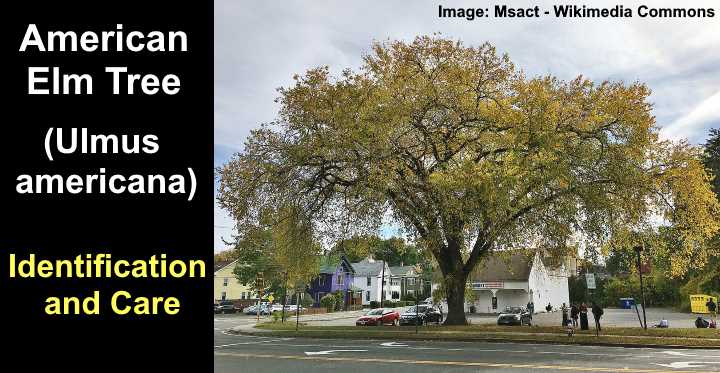
The American elm tree is a popular deciduous broadleaf landscape tree with an attractive shape and fall colors. American elms are identified by their upright-spreading habit that forms an appealing urn-shaped, broad crown.
The American elm is an impressive fast-growing tree with leathery, dark green leaves, yellowish-green dangling flowers, and seeds contained in a papery casing. American elm trees foliage turn a spectacular golden yellow in the fall before the leaves drop.
One of the issues with American elm trees is that they’re highly susceptible to the deadly Dutch Elm disease (DED). Thankfully, there are several hybrid elm tree cultivars that are resistant to DED and are ideal for growing as a shade tree in your yard.
This article is a comprehensive guide to identifying the American elm tree in a landscape. Descriptions and pictures of elm leaves, bark, flowers, and seeds will help you recognize this native tree. Additionally, you will get helpful tips on planting and growing DED-resistant cultivars in your garden landscape.
Facts About American Elm Tree (Ulmus americana)
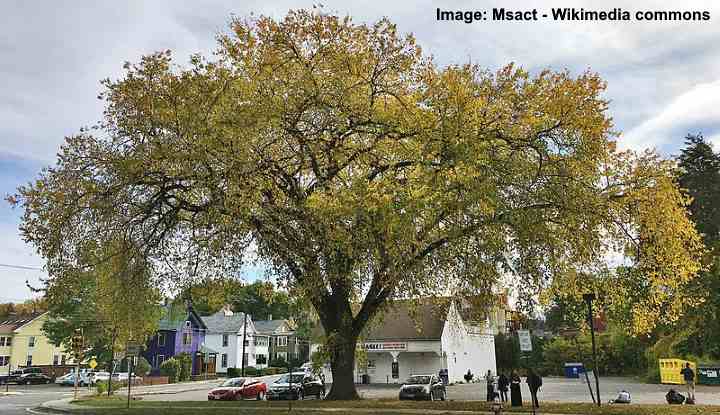
Mature American elm tree (Ulmus americana)
The American elm is an impressive deciduous tree in the family Ulmaceae. The American elm is native to eastern North America but grows well throughout the United States and southern Canada. The hardy tree thrives in USDA zones 2 to 9 and grows 80 to 100 ft. (24 – 30 m) tall when mature.
The American elm is recognized for its beautifully rounded, spreading crown, giving it a high shade canopy. The elm tree’s leathery leaves are dark green with a rough feel and serrated edges. The dense foliage provides plenty of shade in the understory during warm summers, making it a popular shade and street tree.
American elm trees are known for their hardiness. They thrive in warm and humid climates and are popular trees in Central and North Florida landscapes. However, the hardy deciduous trees will also perform well in cold, dry northwest where temperatures dip to 0°F (-18°C). In addition, the versatile tree adapts well to wet and dry locations.
Other common names of the American elm tree include water elm, white elm, Florida elm, and soft elm.
Another fact about the American elm tree is that it has been used for centuries in landscaping. Like many varieties of elm trees, Ulmus americana has ornamental qualities due to its vase-like crown, attractive buttery-yellow fall color, and adaptability.
American Elm Tree Leaves
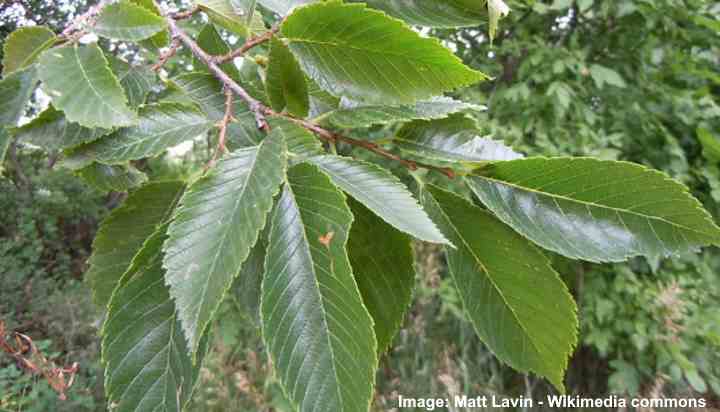
American elm leaves
The leaves on the American elm are dark green, ovate leaves growing in an alternate, simple arrangement. The elm leaves have doubly-serrated edges, an oblique base, and a slightly curved point. The leaves turn golden yellow before dropping to the ground in the fall. Leaves measure 3” to 6” (7 – 15 cm) long.
American Elm Tree Bark

American elm tree bark
The bark of the American elm tree is grayish-brown and develops deep, diamond-shaped furrows as the tree matures. The intersected plated bark has a flaky appearance, especially as the tree ages. One way to identify an American elm tree in the landscape is by peeling the bark to see its wafer-like cross-section.
American Elm Tree Flowers

American elm flowers
Flowers on American elm trees appear in March or April. The small, insignificant flowers are greenish-yellow with tinges of red. The flower clusters dangle down from stalks up to 1” (2.5 cm) long, and three to 15 flowers are in each dangling cluster. The flowers have no petals and are challenging to spot when the tree is in bloom.
American Elm Tree Seeds
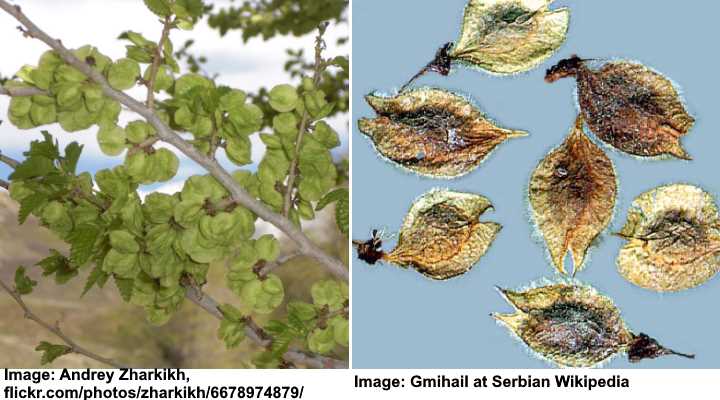
American elm seeds
Seeds from the American elm tree are encased in papery casings called samaras and measure 0.78” (20 mm) long. The flat, oval green-winged samaras often have a reddish center where the seed is located. The clusters of elm seeds appear after the flowers fade, and they are carried away by the wind.
American Elm Tree Identification
The American elm tree is identified in a landscape by its spreading vase-shaped crown. Up close, the elm has identifiable ovate leaves with double-toothed margins and an extended apex. It features grayish-brown rough bark and deep furrows. In the fall, the American elm’s foliage turns golden yellow.
American Elm Trees and Dutch Elm Disease
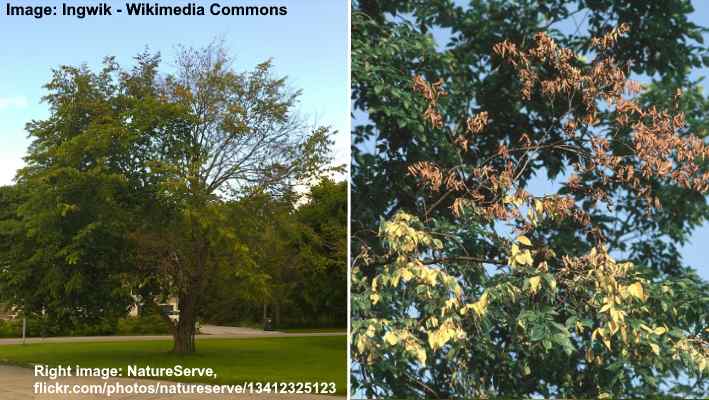
Left picture: elm tree affected by Dutch elm disease (DED). Right image: wilting and yellow leaves on American elm affected by DED
The American elm has been blighted in the landscape by Dutch elm disease. A fungus causes this vascular wilt disease. The fungus blocks water from getting to the tree’s branches and stems, resulting in severe wilting.
The disease is spread by beetles that feed on diseased trees. The culprit is European bark beetles (Scolytus multistriatus) that infect healthy American elms. The beetles feed under the bark, where the fungal infection they carry infects the tree.
Signs of Dutch elm disease include yellowing leaves, diseased yellow leaves dangling from branches, and discolored brown sap emerging from twigs.
American elm tree cultivars resistant to Dutch elm disease
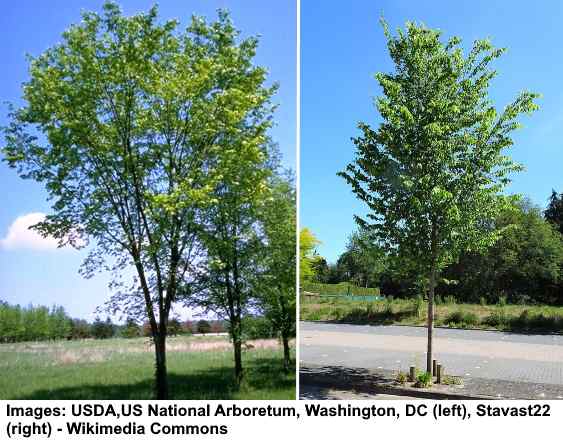
American elm tree cultivars resistant to Dutch elm disease include ‘Valley Forge’ (left) and ‘New Harmony’ (right)
Suppose you want to plant an American elm tree as an attractive vase-shaped shade tree in your yard. In that case, it’s crucial to select a cultivar that has proven resistance to DED.
Here are several American elm cultivars resistant to Dutch elm disease:
Valley Forge—A tall American elm hardy to USDA zone 4 that has the best DED resistance. It grows 70 ft. (21 m) tall, has the classic elm vase shape, and has attractive arching branches.
Prairie Expedition—This elm cultivar thrives in zone 3 to 9 and has spectacular golden yellow fall foliage. This elm has excellent disease resistance and grows up to 70 ft. (21 m) tall.
Princeton—One of the popular disease-resistant American elm trees. It has an attractive vase shape and good upright form.
New Harmony—This American elm cultivar is hardy to zone 5 and has a broad, urn-shaped crown with arching branches.
Where to Plant American Elm Tree
American elm trees are prized in landscapes for their attractive Y-shaped form, dense foliage, and excellent shade properties. However, because they are medium to large hardwood trees with a broad spread, you must consider a suitable location to plant this fast-growing tree.
American elms need full sun to thrive and stay free from disease and pests. Ideally, they should get at least six hours of sunshine daily. Although American elms can withstand partial shade, they can be prone to foliar diseases if there isn’t enough light and heat.
Choose a spot where the ground is consistently moist but well-draining for the best location to plant an American elm. However, you don’t need to worry too much about the type of soil, quality, or drainage. American elm trees are adaptable and grow well in sandy, loamy, or clay soils.
An important consideration when planting an American elm tree is protection from strong winds. American elms are susceptible to storm damage. In addition, they have a relatively shallow root system. Therefore, it’s best to plant them at least 20 ft. (6 m) away from structures and sidewalks.
How to Plant American Elm Tree
American elm trees — especially the Dutch elm disease-resistant ones — are tough, hardy trees. Once established, they adapt well to most growing conditions and thrive with minimal care. So, suppose you want to plant an American elm in your yard. In that case, here is a guide to help you.
First, dig a hole about the same depth as the root ball and 2 or 3 times wider. Then remove all the burlap from the nursery plant and untangle the roots if necessary. Next, place the tree in the hole and backfill with native soil, pressing down with the spade as you go.
The next step is to water the newly-planted elm tree thoroughly. This helps the roots to get established and remove any air pockets. Then apply a 2” to 3” (5 – 7.5 cm) layer of organic mulch to help lock in moisture and prevent weeds from growing through.
After planting, water the elm tree daily for the first week or so. Then, water it regularly during the growing season when there has been no rainfall. Once the American elm tree has been established for a few years, you only need to water it during drought periods.
American Elm Tree Propagation (How to Grow an Elm Tree From Seed)
The two methods to propagate an American elm tree are cuttings or seeds. Typically, taking elm tree cuttings is the best propagation method. However, the elms are also relatively easy to grow from seed.
To propagate an American elm from cuttings: Take cuttings from new growth stem tips, ensuring they are around 6” (15 cm) long. The best time to take the cuttings is in summer after blooming. First, take the cutting just below the node. Then remove all the lower leaves apart from the last few on the top.
Next, make a 1” (2.5 cm) long incision at the base of the cutting on either side. After that, dip in rooting hormone and place in a moist rooting medium consisting of peat moss and perlite. Cover with plastic and place in a warm, sunny spot. Keep the soil moist, and roots should appear in four to six weeks.
To grow an American elm from seed: Harvest elm seeds between March and June and place them in a brown paper bag to dry. Next, remove the seeds from the papery envelope. After that, soak the seeds in room temperature water for 24 hours. Then, remove the seeds, place them in a sealable plastic bag that’s half-filled with sand, and put them in the refrigerator for 30 days.
After you stratify the elm seeds, they are ready for germination. Sow the seeds in individual pots filled with a moist peat moss and sand mixture. Cover, place in a warm, sunny spot, and keep the rooting medium moist.
Once the American elm seedlings are around 6” (15 cm) tall, they are ready for planting outside in the garden.
American Elm Tree (Ulmus americana) Care Guide
Let’s look at some of the best ways to care for an American elm tree in your yard.
How to Water American Elm Tree
An established American elm tree doesn’t require much watering. The stately ornamental tree is relatively drought-tolerant. However, during dry periods, you should provide additional irrigation. The best way to water an American elm tree is to water the ground around the edge of the crown area.
To prevent foliar diseases, avoid splashing water on the leaves or watering the trunk or bark. Therefore, it’s best not to use a sprinkler system to water an American elm.
American Elm Tree Fertilization
The best fertilizer for an American elm tree is a low-nitrogen, slow-release granular tree fertilizer. Therefore, choose a suitable tree fertilizer with an NPK rating of 5-10-10 or 6-12-12. Then, follow the instructions to provide the right amount of fertilizer for the tree’s root area. Only fertilize in spring and possibly in midsummer if necessary.
American Elm Tree Pruning
Pruning an American elm tree should only occur in winter or early spring. This is because elm bark beetles are not active at this time, and you minimize the chance of your prized elm tree getting infected. In addition, annual pruning is necessary to remove dead branches and prevent branches from rubbing together.
Every three years, you should prune the live branches off the elm tree to improve its shape and appearance and increase air circulation. Start by pruning a few branches from the upper and middle portions of the tree. Additionally, you can remove limbs that stick out and spoil the tree’s appearance.
It’s good to note that many states have orders banning elm tree pruning during certain months. Also, it’s best to destroy all removed branches and foliage to prevent attracting elm bark beetles. And you should avoid burning pruned branches — this can also attract destructive beetles.
If you notice signs of Dutch elm disease, it’s best to call in professionals to remove the diseased tree.
Top tip when pruning elm trees: Don’t remove more than one-third of the canopy at a time; otherwise, the tree could die.
Pests Affecting American Elm Tree Growth
Although American elms are beautiful ornamental landscape trees, they are susceptible to various pests. The most destructive insect is the elm bark beetle that spreads the lethal Dutch elm disease. However, other bugs can affect native elm trees.
European elm bark beetle (Scolytus multistriatus) is a non-native small brown beetle that infects elms with DED. Unlike the native elm bark beetle (Hylurgopinus rufipes) that only affects dying elms, the European beetle feeds on healthy elms.
Elm leaf beetle (Xanthogaleruca luteola) is an invasive yellow or green beetle that feeds on the leaves of elm trees. Beetles that affect elm trees are difficult to control or get rid of.
Fall webworms are hairy white caterpillars that live in large silky tents dangling on the ends of branches. Also called tent caterpillars, the voracious caterpillars only do limited damage to the foliage around their tents. The best way to control the pesky bugs is to remove the tents and drop them into soapy water.
Elm sawfly (Cimbex americanus) is a black wasp that lays its eggs on elm trees. If there is a significant invasion, the large white grubs can completely defoliate elm trees.
Woolly elm aphid (Eriosoma Americanum) is a sap-sucking, destructive pest that feeds on native elm trees, causing the leaves to become twisted, curled, and distorted. Opening infected leaves reveals a mass of woolly aphids. This may be accompanied by honeydew and black sooty mold.
Diseases Affecting American Elm Tree Growth
American elm trees are beautiful trees in landscapes or lining streets. But unfortunately, disease has affected nearly all native American elm trees since the 1930s. Although many disease-resistant cultivars are available, elm disease still affects trees.
Dutch elm disease (Ophiostoma ulmi) is caused by a fungus carried by elm bark beetles. Signs of this disease include wilting, yellow leaves that fall prematurely. As the disease progresses, brown streaks in characteristic patterns appear on the trunk.
Black leaf spot (Stegophora ulmea) is a foliar fungal disease that causes yellow and black spots to appear on the leaves. This disease is most common in the American elm species.
Powdery mildew shows up as a white waxy or powdery coating on the surface of deciduous trees, including American elms. Because it occurs late in the season, there is no need to worry about this relatively harmless fungal leaf disease. Ways to avoid powdery mildew on elms include increasing air circulation, planting trees in full sun, and avoiding watering foliage.
Related articles:
